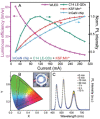Recent Advances in Ligand Design and Engineering in Lead Halide Perovskite Nanocrystals
- PMID: 34194945
- PMCID: PMC8224438
- DOI: 10.1002/advs.202100214
Recent Advances in Ligand Design and Engineering in Lead Halide Perovskite Nanocrystals
Abstract
Lead halide perovskite (LHP) nanocrystals (NCs) have recently garnered enhanced development efforts from research disciplines owing to their superior optical and optoelectronic properties. These materials, however, are unlike conventional quantum dots, because they possess strong ionic character, labile ligand coverage, and overall stability issues. As a result, the system as a whole is highly dynamic and can be affected by slight changes of particle surface environment. Specifically, the surface ligand shell of LHP NCs has proven to play imperative roles throughout the lifetime of a LHP NC. Recent advances in engineering and understanding the roles of surface ligand shells from initial synthesis, through postsynthetic processing and device integration, finally to application performances of colloidal LHP NCs are covered here.
Keywords: device integration; ligand characterization; ligand engineering; nanocrystal surface design; optical and optoelectronic properties; perovskite nanocrystals; stability.
© 2021 The Authors. Advanced Science published by Wiley‐VCH GmbH.
Conflict of interest statement
The authors declare no conflict of interest.
Figures















Similar articles
-
Microcarrier-Assisted Inorganic Shelling of Lead Halide Perovskite Nanocrystals.ACS Nano. 2019 Oct 22;13(10):11642-11652. doi: 10.1021/acsnano.9b05481. Epub 2019 Oct 10. ACS Nano. 2019. PMID: 31585035 Free PMC article.
-
Ligands in Lead Halide Perovskite Nanocrystals: From Synthesis to Optoelectronic Applications.Small. 2023 Mar;19(11):e2205950. doi: 10.1002/smll.202205950. Epub 2022 Dec 14. Small. 2023. PMID: 36515335 Review.
-
Lead Halide Perovskite Nanocrystals with Low Inhomogeneous Broadening and High Coherent Fraction through Dicationic Ligand Engineering.Nano Lett. 2023 Feb 22;23(4):1128-1134. doi: 10.1021/acs.nanolett.2c03354. Epub 2023 Feb 13. Nano Lett. 2023. PMID: 36780509
-
Toward the Controlled Synthesis of Lead Halide Perovskite Nanocrystals.ACS Nano. 2023 Sep 26;17(18):17600-17609. doi: 10.1021/acsnano.3c05609. Epub 2023 Sep 8. ACS Nano. 2023. PMID: 37683288 Review.
-
Effect of Surface Ligands in Perovskite Nanocrystals: Extending in and Reaching out.Acc Chem Res. 2021 Mar 16;54(6):1409-1418. doi: 10.1021/acs.accounts.0c00712. Epub 2021 Feb 11. Acc Chem Res. 2021. PMID: 33570394 Free PMC article.
Cited by
-
Influence of arylalkyl amines on the formation of hybrid CsPbBr3 nanocrystals via a modified LARP method.Nanoscale Adv. 2024 Feb 6;6(6):1704-1719. doi: 10.1039/d3na01105d. eCollection 2024 Mar 12. Nanoscale Adv. 2024. PMID: 38482026 Free PMC article.
-
Perovskite spin light-emitting diodes with simultaneously high electroluminescence dissymmetry and high external quantum efficiency.Nat Commun. 2025 Mar 5;16(1):2201. doi: 10.1038/s41467-025-57472-8. Nat Commun. 2025. PMID: 40038280 Free PMC article.
-
Hybrid Amino Acid Ligand-Regulated Excited Dynamics of Highly Luminescent Perovskite Quantum Dots for Bright White Light-Emitting Diodes.Nanomaterials (Basel). 2024 Jul 29;14(15):1266. doi: 10.3390/nano14151266. Nanomaterials (Basel). 2024. PMID: 39120371 Free PMC article.
-
Simple and sustainable synthesis of perovskite-based optoelectronic material: CsPbBr3 nanocrystals via laser ablation in alcohol.Nanoscale Adv. 2022 Oct 12;4(23):5009-5014. doi: 10.1039/d2na00596d. eCollection 2022 Nov 22. Nanoscale Adv. 2022. PMID: 36504746 Free PMC article.
-
Ultrafast and Radiation-Hard Lead Halide Perovskite Nanocomposite Scintillators.ACS Energy Lett. 2023 Aug 28;8(9):3883-3894. doi: 10.1021/acsenergylett.3c01396. eCollection 2023 Sep 8. ACS Energy Lett. 2023. PMID: 37705701 Free PMC article.
References
-
- Alivisatos A. P., Science 1996, 271, 933.
-
- Murray C., Norris D. J., Bawendi M. G., J. Am. Chem. Soc. 1993, 115, 8706.
-
- Talapin D. V., Lee J.‐S., Kovalenko M. V., Shevchenko E. V., Chem. Rev. 2010, 110, 389. - PubMed
-
- Burda C., Chen X., Narayanan R., El‐Sayed M. A., Chem. Rev. 2005, 105, 1025. - PubMed
-
- Yin Y., Alivisatos A. P., Nature 2005, 437, 664. - PubMed
Publication types
LinkOut - more resources
Full Text Sources
Other Literature Sources
Research Materials
